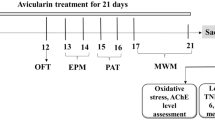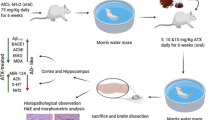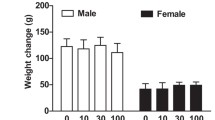Abstract
Rationale
In Alzheimer’s disease (AD), the deposition of amyloid peptides is invariably associated with oxidative stress and inflammatory responses. Xanthoceraside has anti-inflammatory and antioxidative activities. However, it remains unclear whether xanthoceraside improves amyloid β (Aβ)-induced neurotoxicity.
Objectives
The purpose of this study was to examine the effect of xanthoceraside on behavioral impairments, inflammatory responses, and oxidative stress induced by Aβ peptide25–35 (Aβ25–35) in mice.
Materials and methods
The mice were treated orally with xanthoceraside (0.02, 0.08, or 0.32 mg/kg, once daily) after the intracerebroventricular injection of Aβ25–35 (day 0). Cognitive functions were evaluated in Y-maze (day 6) and novel object recognition tests (days 7 and 8). Inducible nitric oxide synthase (iNOS) and nitrotyrosine levels in the hippocampus were examined (day 9). The mRNA expressions of iNOS and interleukin-4 (IL-4) in the hippocampus were measured 2 h and 3 days after the Aβ25–35 injection by real-time reverse transcription-polymerase chain reaction.
Results
Xanthoceraside significantly attenuated behavioral impairments induced by Aβ25–35 in the Y-maze and novel object recognition tests. Repeated treatment with xanthoceraside significantly inhibited the increase in the expression of iNOS and nitrotyrosine in the hippocampus induced by Aβ25–35, which is associated with an enhanced expression of the IL-4 mRNA.
Conclusions
These findings suggest that xanthoceraside attenuates memory impairments through amelioration of oxidative stress and inflammatory responses induced by Aβ25–35 and is a potential candidate for an AD treatment.






Similar content being viewed by others
Abbreviations
- Aβ:
-
Amyloid β
- Aβ25–35 :
-
Amyloid β peptide25–35
- Aβ35–25 :
-
Amyloid β peptide35–25
- AD:
-
Alzheimer’s disease
- Ct:
-
Threshold cycles
- i.c.v.:
-
Intracerebroventricularly
- IL-1β:
-
Interleukin-1β
- IL-4:
-
Interleukin-4
- iNOS:
-
Inducible nitric oxide synthase
- LTP:
-
Long-term potentiation
- NO:
-
Nitric oxide
- p.o.:
-
Per os
- RT-PCR:
-
Reverse transcription-polymerase chain reaction
- SDS:
-
Sodium dodecyl sulfate
- TNF-α:
-
Tumor necrosis factor-α
References
Akama KT, Van Eldik LJ (2000) β-Amyloid stimulation of inducible nitric oxide synthase in astrocytes is IL-1β- and TNF-α-dependent, and involves a TNF-α receptor-associated factor- and NF kappa B-inducing kinase-dependent signaling mechanism. J Biol Chem 275:7918–7924
Alkam T, Nitta A, Mizoguchi H, Saito K, Seshima M, Itoh A, Yamada K, Nabeshima T (2008) Restraining tumor necrosis factor-alpha by thalidomide prevents the amyloid β-induced impairment of recognition memory in mice. Behav Brain Res 189:100–106
Banati RB, Gehrmann J, Schubert P, Kreutzberg GW (1993) Cytotoxicity of microglia. Glia 7:111–118
Blennow K, de Leon MJ, Zetterberg H (2006) Alzheimer’s disease. Lancet 368:387–403
Bolanos JP, Almeida A, Stewart V, Peuchen S, Land JM, Clark JB, Heales SJ (1997) Nitric oxide-mediated mitochondrial damage in the brain: mechanisms and implications for neurodegenerative diseases. J Neurochem 68:2227–2240
Butovsky O, Koronyo-Hamaoui M, Kunis G, Ophir E, Landa G, Cohen H, Schwartz M (2006) Glatiramer acetate fights against Alzheimer's disease by inducing dendritic-like microglia expressing insulin-like growth factor 1. Proc Natl Acad Sci USA 103:11784–11789
Butterfield DA, Castegna A, Lauderback CM, Drake J (2002) Evidence that amyloid beta-peptide-induced lipid peroxidation and its sequelae in Alzheimer’s disease brain contribute to neuronal death. Neurobiol Aging 23:655–664
Butterfield DA, Reed T, Newman SF, Sultana R (2007) Roles of amyloid beta-peptide-associated oxidative stress and brain protein modifications in the pathogenesis of Alzheimer’s disease and mild cognitive impairment. Free Radic Biol Med 43:658–677
Chao CC, Hu S, Molitor TW, Shaskan EG, Peterson PK (1992) Activated microglia mediate neuronal cell injury via a nitric oxide mechanism. J Immunol 149:2736–2741
Chi TY, Wang LH, Qu C, Yang BZ, Ji XF, Wang Y, Okuyama T, Yoshihito O, Zou LB (2009) Protective effects of xanthoceraside on learning and memory impairment induced by Abeta (25–35) in mice. J Asian Nat Prod Res 11:1019–1027
Chi TY, Wang LH, Ji XF, Li W, Wang Y, Zou LB (2010) Protective effects of xanthoceraside on learning and memory impairment induced by intracerebroventricular injections of Aβ1–42 in mice. J Shenyang Pharm Univ 27:314–319
Clarke RM, O'Connell F, Lyons A, Lynch MA (2007) The HMG-CoA reductase inhibitor, atorvastatin, attenuates the effects of acute administration of amyloid-beta1–42 in the rat hippocampus in vivo. Neuropharmacology 52:136–145
Coccia EM, Stellacci E, Marziali G, Weiss G, Battistini A (2000) IFN-gamma and IL-4 differently regulate inducible NO synthase gene expression through IRF-1 modulation. Int Immunol 12:977–985
Combs CK, Karlo JC, Kao SC, Landreth GE (2001) β-Amyloid stimulation of microglia and monocytes results in TNF-α dependent expression of inducible nitric oxide synthase and neuronal apoptosis. J Neurosci 21:1179–1188
Gruden MA, Davidova TB, Malisauskas M, Sewell RD, Voskresenskaya NI, Wilhelm K, Elistratova EI, Sherstnev VV, Morozova-Roche LA (2007) Differential neuroimmune markers to the onset of Alzheimer’s disease neurodegeneration and dementia: autoantibodies to Abeta(25–35) oligomers, S100b and neurotransmitters. J Neuroimmunol 186:181–192
Heneka MT, Loschmann PA, Gleichmann M, Weller M, Schulz JB, Wullner U, Klockgether T (1998) Induction of nitric oxide synthase and nitric oxide-mediated apoptosis in neuronal PC12 cells after stimulation with tumor necrosis factor-alpha/lipopolysaccharide. J Neurochem 71:88–94
Hewett SJ, Csernansky CA, Choi DW (1994) Selective potentiation of NMDA-induced neuronal injury following induction of astrocytic iNOS. Neuron 13:487–494
Institute for Laboratory Animal Research (1996) Guide for the Care and Use of Laboratory Animals, 7th ed. Commission on Life Sciences, National Research Council, Washington, DC. http://www.nap.edu/catalog/5140.html
Ishii K, Muelhauser F, Liebl U, Picard M, Kühl S, Penke B, Bayer T, Wiessler M, Hennerici M, Beyreuther K, Hartmann T, Fassbender K (2000) Subacute NO generation induced by Alzheimer’s beta-amyloid in the living brain: reversal by inhibition of the inducible NO synthase. FASEB J 14:1485–1489
Kiyota T, Okuyama S, Swan RJ, Jacobsen MT, Gendelman HE, Ikezu T (2010) CNS expression of anti-inflammatory cytokine interleukin-4 attenuates Alzheimer’s disease-like pathogenesis in APP+PS1 bigenic mice. FASEB J 24:3093–3102
Klementiev B, Novikova T, Novitskaya V, Walmod PS, Dmytriyeva O, Pakkenberg B, Berezin V, Bock E (2007) A neural cell adhesion molecule-derived peptide reduces neuropathological signs and cognitive impairment induced by Abeta25–35. Neuroscience 145:209–224
Kubo T, Nishimura S, Kumagae Y, Kaneko I (2002) In vivo conversion of racemized beta-amyloid ([D-Ser 26] Abeta 1–40) to truncated and toxic fragments ([D-Ser 26]Abeta 25–35/40) and fragment presence in the brains of Alzheimer’s patients. J Neurosci Res 70:474–483
Lalonde R (2002) The neurobiological basis of spontaneous alternation. Neurosci Biobehav Rev 26:91–104
Ledeboer A, Brevé JJ, Poole S, Tilders FJ, Van Dam AM (2000) Interleukin-10, interleukin-4, and transforming growth factor-beta differentially regulate lipopolysaccharide-induced production of pro-inflammatory cytokines and nitric oxide in co-cultures of rat astroglial and microglial cells. Glia 30:134–142
Lee SC, Zhao ML, Hirano A, Dickson DW (1999) Inducible nitric oxide synthase immunoreactivity in the Alzheimer disease hippocampus: association with Hirano bodies, neurofibrillary tangles, and senile plaques. J Neuropathol Exp Neurol 58:1163–1169
Liu XX, Ji XF, Lu LL, Yang BZ, Wang LH, Zou LB (2007) Improvement of ethanol extract from husk of Xanthoceras sorbifolia on rats with learning and memory dysfunction. Chin Tradit Herb Drugs 12:106–110
Lu P, Mamiya T, Mouri A, Lu LL, Nagai T, Hiramatsu M, Zou LB, Ikejima T, Nabeshima T (2009a) Silibinin prevents amyloid β peptide-induced memory impairment and oxidative stress in mice. Br J Pharmacol 157:1270–1277
Lu P, Mamiya T, Lu LL, Mouri A, Niwa M, Hiramatsu M, Zou LB, Nagai T, Ikejima T, Nabeshima T (2009b) Silibinin attenuates amyloid beta(25–35) peptide-induced memory impairments: implication of inducible nitric-oxide synthase and tumor necrosis factor-alpha in mice. J Pharmacol Exp Ther 331:319–326
Lyons A, Griffin RJ, Costelloe CE, Clarke RM, Lynch MA (2007) IL-4 attenuates the neuroinflammation induced by amyloid-beta in vivo and in vitro. J Neurochem 101:771–781
Maurice T, Lockhart BP, Privat A (1996) Amnesia induced in mice by centrally administered β-amyloid peptides involves cholinergic dysfunction. Brain Res 706:181–193
Meda L, Cassatella MA, Szendrei GI, Otvos L Jr, Baron P, Villalba M, Ferrari D, Rossi F (1995) Activation of microglial cells by beta-amyloid protein and interferon-gamma. Nature 374:647–650
Medeiros R, Prediger RD, Passos GF, Pandolfo P, Duarte FS, Franco JL, Dafre AL, Di Giunta G, Figueiredo CP, Takahashi RN, Campos MM, Calixto JB (2007) Connecting TNF-alpha signaling pathways to iNOS expression in a mouse model of Alzheimer’s disease: relevance for the behavioral and synaptic deficits induced by amyloid beta protein. J Neurosci 27:5394–5404
Meunier J, Ieni J, Maurice T (2006) The anti-amnesic and neuroprotective effects of donepezil against amyloid beta25–35 peptide-induced toxicity in mice involve an interaction with the sigma1 receptor. Br J Pharmacol 149:998–1012
Molina-Holgado E, Arévalo-Martín A, Castrillo A, Boscá L, Vela JM, Guaza C (2002) Interleukin-4 and interleukin-10 modulate nuclear factor kappaB activity and nitric oxide synthase-2 expression in Theiler’s virus-infected brain astrocytes. J Neurochem 81:1242–1252
Morishima Y, Gotoh Y, Zieg J, Barrett T, Takano H, Flavell R, Davis RJ, Shirasaki Y, Greenberg ME (2001) Beta-amyloid induces neuronal apoptosis via a mechanism that involves the c-Jun N-terminal kinase pathway and the induction of Fas ligand. J Neurosci 21:7551–7560
Pike CJ, Walencewicz-Wasserman AJ, Kosmoski J, Cribbs DH, Glabe CG, Cotman CW (1995) Structure-activity analyses of β-amyloid peptides: contributions of the β25–35 region to aggregation and neurotoxicity. J Neurochem 64:253–265
Reiter CD, Teng RJ, Beckman JS (2000) Superoxide reacts with nitric oxide to nitrate tyrosine at physiological pH via peroxynitrite. J Biol Chem 275:32460–32466
Sands WA, Bulut V, Severn A, Xu D, Liew FY (1994) Inhibition of nitric oxide synthesis by interleukin-4 may involve inhibiting the activation of protein kinase C epsilon. Eur J Immunol 24:2345–2350
Smith MA, Richey Harris PL, Sayre LM, Beckman JS, Perry G (1997) Widespread peroxynitrite-mediated damage in Alzheimer’s disease. J Neurosci 17:2653–2657
Stepanichev MY, Zdobnova IM, Zarubenko II, Moiseeva YV, Lazareva NA, Onufriev MV, Gulyaeva NV (2004) Amyloid-beta(25–35)-induced memory impairments correlate with cell loss in rat hippocampus. Physiol Behav 80:647–655
Stepanichev MY, Zdobnova IM, Zarubenko II, Lazareva NA, Gulyaeva NV (2006) Studies of the effects of central administration of β-amyloid peptide (25–35): pathomorphological changes in the hippocampus and impairment of spatial memory. Neurosci Behav Physiol 36:101–106
Tanaka M, Sotomatsu A, Yoshida T, Hirai S, Nishida A (1994) Detection of superoxide production by activated microglia using a sensitive and specific chemiluminescence assay and microglia-mediated PC12h cell death. J Neurochem 63:266–270
Tran MH, Yamada K, Olariu A, Mizuno M, Ren XH, Nabeshima T (2001) Amyloid beta-peptide induces nitric oxide production in rat hippocampus: association with cholinergic dysfunction and amelioration by inducible nitric oxide synthase inhibitors. FASEB J 15:1407–1409
Tran MH, Yamada K, Nakajima A, Mizuno M, He J, Kamei H, Nabeshima T (2003) Tyrosine nitration of a synaptic protein synaptophysin contributes to amyloid beta-peptide-induced cholinergic dysfunction. Mol Psychiatry 8:407–412
Walsh DM, Selkoe DJ (2004) Deciphering the molecular basis of memory failure in Alzheimer’s disease. Neuron 44:181–193
Wallace MN, Geddes JG, Farquar DA, Masson MR (1997) Nitric oxide synthase in reactive astrocytes adjacent to β-amyloid. Exp Neurol 144:266–272
Xie QW, Cho HJ, Calaycay J, Mumford RA, Swiderek KM, Lee TD, Ding A, Troso T, Nathan C (1999) Cloning and characterization of inducible nitric oxide synthase from mouse macrophages. Science 256:225–228
Acknowledgments
This study was supported by Grants-in-aid for Scientific Research (A) (22248033), Scientific Research (B) (20390073, 21390045), and Exploratory Research (19659017, 22659213); and the joint research project of the Japan-Korea basic scientific cooperation program from JSPS; by the “Academic Frontier” Project for Private Universities (2007–2011) and by a Regional Joint Research Program supported by grants to Private Universities to Cover Current Expenses from the Ministry of Education, Culture, Sports, Science and Technology of Japan (MEXT); by Research on Regulatory Science of Pharmaceuticals and Medical Devices; and by Research on Risk of Chemical Substances, Health and Labour Science Research Grants supported by the Ministry of Health, Labour and Welfare, Japan (MHLW).
Statement of conflicts of interest
The authors state no conflict of interest.
Author information
Authors and Affiliations
Corresponding authors
Rights and permissions
About this article
Cite this article
Lu, P., Mamiya, T., Lu, L. et al. Xanthoceraside attenuates amyloid β peptide25–35-induced learning and memory impairments in mice. Psychopharmacology 219, 181–190 (2012). https://doi.org/10.1007/s00213-011-2386-1
Received:
Accepted:
Published:
Issue Date:
DOI: https://doi.org/10.1007/s00213-011-2386-1




